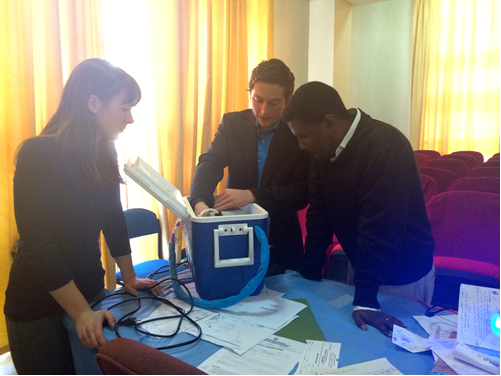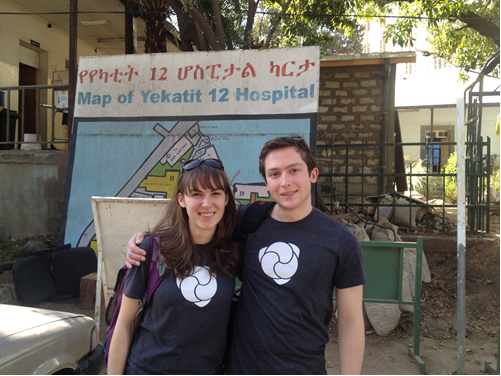Goals of the project
PremieBreathe is dedicated to improving access to medical technologies in the low-resource world. Currently, the majority of deaths in low-income settings are avoidable, but hospitals lack access to adequate medical devices.
At the moment, PremieBreathe is focused on developing a low-cost infant respiratory aid. The international development community, including the World Bank, the United Nations, and the World Health Organization, identified reducing under-5 mortality as a key objective – central to achieving this goal is reducing newborn deaths. For instance, in Ethiopia, 29/1000 newborns do not survive the crucial first 28 days of life, more formally known as the neonatal period. Over 50% of these deaths have some component of respiratory insufficiency
PremieBreathe is aiming to reduce respiratory related neonatal deaths through the development of a low-cost humidified high flow nasal cannula (HHFNC). HHFNC is the standard of care for newborn infants in the developed world, but the technology is prohibitively expensive for much of the developing world. Effective therapy requires the delivery of air warmed to 32°C and 95% relative humidity. Given these simple parameters, PremieBreathe has been able to create a functional prototype and is preparing for field-testing in Ethiopia.
Nature of the Collaboration
PremieBreathe is a truly interdisciplinary venture, uniting doctors, engineers, and global health professionals.
PremieBreathe’s engineers use their backgrounds in both mechanical and biomedical for device development. With the help of faculty in both departments, they have solved problems related to bacterial contamination, airflow, and heating.
As with any medical device, input and guidance from doctors is key – PremieBreathe is fortunate enough to work with a pediatrician at Yale–New Haven Hospital. He aids our engineers to make sure we build a device that meets clinically mandated metrics.
Finally, PremieBreathe enjoys support from the Yale Global Health Leadership Institute (GHLI). GHLI provides general oversight to ensure the team develops a device appropriate for deployment in a low-income setting. Furthermore, GHLI has connected the team with doctors and physicians at Ayder Referral Hospital, in Tigray, Ethiopia, who provide ongoing support and clinical design assistance.
Building a medical device is a complicated task but by bringing together an interdisciplinary team, PremieBreathe will create a device appropriate to low-resource settings.
Skills
Coding: Programming knowledge was key to developing the temperature regulator software.
3D Design: Modeling is a valuable tool to test designs before fabrication. PremieBreathe made use of SolidWorks to design and check vales and junctions.
Soldering: Coding is only useful if the hardware exists to implement it. To that end, soldering was a necessary skill to assemble the device’s circuitry.
Machining: While we are minimizing those parts that have to be individually machined, PremieBreathe uses lathes and mills to create come device components.
Tools
Arduino: While PremieBreathe aims to reduce electronics, those that are present are regulated through an Arduino.
MakerBot: 3D printing allowed for the rapid prototyping of tubing junctions and other components.
Laser Cutter: PremieBreathe has used laser cutters to create housing components.
Process
PremieBreathe initially went through a very rapid prototype process. As Center for Engineering Innovation and Design Summer Fellows (2014), the team worked through three iterative prototypes. Each one demonstrated additional device functionality such as achieving and maintaining desired air flow rates.
Originally, while building a low-tech device, PremieBreathe did financially constrain itself. However, after the proof of concept prototyping, the team moved toward reducing costs.
At present, the team is busy incorporating user feedback from Ethiopian doctors. A primary concern for physicians is the current device footprint, so the team is working to reduce the volume by half. After this and other feedback is incorporated, the team will work with a design firm to complete industrial engineering.
Milestones
Proof of Concept Prototype
In September 2014, the team succeeded in creating a proof of concept prototype using widely available materials and components, for a total cost of less than USD 400.
Ethiopia Research Trip
PremieBreathe traveled to northern Ethiopia in January 2015. The trip served as an opportunity to interact with end–users and collect valuable feedback on how to improve the applicability of the device to low-resource settings.
Challenges encountered
Bacterial Contamination
Although the team has solved some of the initial challenges surrounding bacterial contamination, there are still problems to overcome related to access to clean water. Combating bacterial contamination has taught us that sometimes solving a problem requires more than one approach, and that breaking it into smaller sub-challenges is extremely helpful.
Development of Heating System
Price constraints made the purchase of a commercial temperature regulator impossible. Designing one from scratch required combining knowledge of thermodynamics, fluid mechanics, and electronics. More than anything, creating the heating system taught the team to ask for help – all engineers have required help at some point and love to pay it forward and help others out.
Major outcomes
So far, PremieBreathe has succeeded in creating a fully functional prototype. The device achieves and maintains airflow, temperature, and humidity targets and can be created with only USD 400 worth of parts and components. A research trip to Ethiopia provided valuable end-user input that is being incorporated into the device prior to manufacturing.
Innovations, impact and successes
PremieBreathe is committed to helping reduce neonatal death in the low-income world. Once implemented, it is expected the device can positively impact the treatment of 45,000 infants annually, just in Ethiopia. Perhaps the greatest tangible impact so far has been PremieBreathe’s success in uniting students and faculty from across the University to achieve a common goal.
 Katy Chan
Katy Chan
 Jordan Sabin
Jordan Sabin
 Shirin Ahmed
Shirin Ahmed


